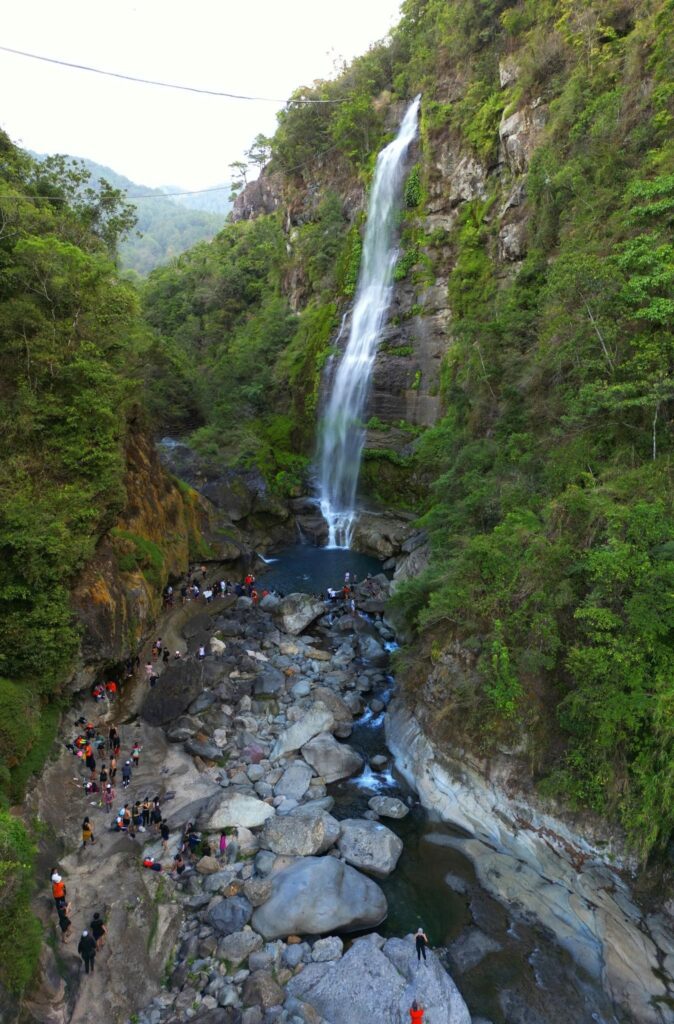Top 5 Things To Do in Sagada:
1. Sumaguing Cave Spelunking
2. Hike to Bomod-ok Waterfalls
3. Photography Tour at Masferre
4. Viewing the Hanging Coffins and the old Anglican Church
5. Visiting Sagada Weaving
Sagada, located in Northern Philippines, is a popular destination for backpackers, nature lovers, and adventure seekers. Situated at 2,374 feet above sea level, its pine-clad mountains provide a cool climate for most of the year. Sagada offers a variety of tourist spots and outdoor activities for visitors.
Sumaguing Cave Spelunking
Exploring the depths of the earth is Sagada’s main attraction. With the necessary equipment, a trusted guide, and payment of local fees, anyone can experience this adventure. Stalactites and stalagmites long formed millions of years ago are ready for each adventurer to take a peek at.
Descending for almost two hours into the void, exploring in the darkness is an added challenge.
In full display are rock formations, and fossils. Numerous stone formation there is an elephant head, the male and female genitalia, and a turtle. This to include, a huge curtain, numerous pools and terraces, a pregnant lady, and fossils preserved in the limestones are the attractions.
Residents inside the cave includes bats, swallows, and numerous insects.
At the base is a swimming pool, the waters almost freezing. Taking a dip in its cool waters is a good try.
Walking through the bare limestones beneath its cavernous passageways offers a unique experience in spelunking. Getting in, with proper attire, makes it an easier caving adventure.
It is not a walk in the park. Expect to be wet, muddy, and frozen. You will be exhaling water vapors as the tour progresses.
Getting in is the easy part. Sufficient lighting is required, easily provided by the tour guides.
Many more caves are for the offing at Sagada. Requiring the presence of a trained cave guide, however, is a must.
Hike to Bomod-ok Waterfalls

Going to Bomod-ok Waterfalls is mostly a downhill trek, passing through panoramic rice terraces.
Bomod-ok speaks for itself. Bomod-ok in the native dialect means “to gush forth”. Situated in the northern part of town, it takes thirty minutes to an hour to reach. Bangaan barangay is the registration and entry point. It is a part of the bigger Fedilisan Heritage Village.
The pathways leading to the waterfall are mostly paved. Requiring repairs are a few intermittent portions, partly damaged by typhoons.
Bomod-ok Waterfalls is awesome. It is most powerful in the rainy season. It is not advisable to swim in its water at such times. The current is fast and small stones, mud, and debris are a concern.
On the contrary, the water is relatively still in the dry season, and a refreshing bath is always a guarantee.
Photography Tour at Masferre’

Visiting and seeing the works of the Philippines’s Father of Photography Eduardo Masferre is a historical experience. It is the visual story of the interior Cordillera. Captured in film almost a century ago. In black and white, is the culture and tradition of a people revealed in photographs.

Offering an amiable hosting facility in the town proper, is the Masferre Country Inn & Restaurant. Prominently displayed in its dining area are some of the works of the photography icon.
Shooting it in the early 1930s up to the mid-1950s. Most of his frames depicts the life in the Cordillera highlands.
Exhibiting his works, starting in the 1980s, are prestigious institutions. These are the National Museum of Natural History, the Museum of Yale University, and the Smithsonian Institution, to name a few. Displaying his works, lately, is a museum in Germany.
Viewing the Hanging Coffins and the old Anglican Church

Precariously hanging in cliffs at Echo Valley are the coffins of long-gone Sagada ancestors. Perched on metal spikes inserted at the cliff’s face; and tied securely; such marvels puzzle visitors.
Sagada elders claim that such burial practices have always been a part of their culture. An open-air burial allows the spirit to freely return to the spirit realm.
To place the coffin into the cliff takes enormous tasks and construction skills. Building the scaffolding, up to 40 meters into the air, takes days. Drilling the steel spikes into the cliff’s face or inserting in crevasses serves as the base of the coffin. Carving them out of hollowed-out logs or made out of thick pine boards. The coffin is tied securely by rattan strips or ropes and left exposed into the air.
Dismantling the scaffolding is mandatory after the burial.
Numerous burial caves are present at Sagada. The hanging coffins are the main draw, due partly to their well-exposed location, and the heights where they are placed.

The Church of Saint Mary the Virgin is an Anglican Church. It is an enduring legacy of the American colonizers to Sagada and is located in the town proper. It is the largest of 3 Episcopalian stone churches that exist in Mountain Province.
The church sturdy has stonewalls and stone cobbled floors, reflecting an American architectural heritage with a touch of indigenous ingenuity. Built by stonemasons, the church, continues to shelter Sagada’s Episcopalian beliefs to this day.
Visiting Sagada Weaving

Sagada weaving in itself is an institution. It is the home of quality handwoven products. Established way back in 1968, it showcases Sagada’s original weaving designs.
Continuing through the years, it now is a leading establishment in showcasing Sagada’s weaving industry.
Its shop offers a variety of souvenirs, tokens, and keepsakes for visitors wanting to take hold of Sagada’s arts and crafts. Touring the immediate vicinity of the shop is an option, with the assistance of the amiable owner.
Nature tripping, arts and crafts, hiking, spelunking, and camping, Sagada has a lot to offer. Scratching the surface is only the beginning, and these 5 top things to do at Sagada serve as an eye-opener.


One Response